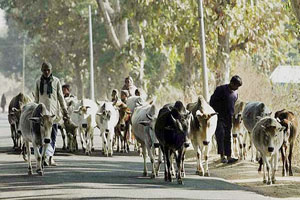
The economics of Eid ul-Azha
Muhammad Abdul Mazid | Thursday, 24 September 2015

Eid ul-Azha, celebrated after two months and ten days of Eid ul-Fitr, is known as the Feast of Sacrifice, as animals are sacrificed in commemoration of willingness of Hazrat Ibrahim (pbh) to sacrifice his dearest son Ismail as an act of obedience to Allah, before He intervened to provide him with a sheep to sacrifice instead. This festival is incorporated in the great pilgrimage to Mecca, and it is also observed all over the Muslim world at the same time. The underlying importance of this festival is the spirit of sacrifice (qurbani) in memory of Hazrat Ibrahim's great act of faith many centuries ago.
The feast of sacrifice, in effect, has an enormous socio-economic significance. Eid ul-Azha corresponds to the performing of Hajj by the financially able Muslims and the national economy has to transact a substantial amount of money, mostly in foreign currency on this occasion. This year one hundred ten thousands five hundred seventy six Muslims from Bangladesh have gone to Saudi Arabia for performing Hajj. Each pilgrim is expected to spend, on an average, three hundred thousand taka which entails a total of around 415 million in US dollars.
The Hajj has been a major source of foreign currency income for the Saudi economy and an important foreign exchange outlay since the earliest days when the hajj was introduced. Bangladesh economy has to handle a substantial deposit as well as disbursement by the banking sectors. There is also the prospect of job creation in aide to the pilgrims.
The festival entails huge financial and economic activities for Bangladesh. According to the Department of Livestock, around six million cows and more than one million goats and sheep are slaughtered annually in Bangladesh. Out of this, sixty per cent of the cows and fifty five per cent of goats and sheep are sacrificed in Eid ul-Azha each year. According to Bangladesh Tanners' Association (BTA), about 3.8 million cows and half a million goats and sheep will the sacrificed this year. In that case, total trading will involve about Tk 135 billion for cows and around Tk 8.25 billion for goats and sheep.
Bangladesh is dependent on supply of cows and goats from India. Eid ul-Azha is the main season for procuring hides and skins for domestic as well as export purposes. Sixty per cent of the export of hides and skins is made following the celebration of this festival.
The money market, which usually gets volatile during the Eid festivals, has remained calm in a fairly liquid position this time ahead of Eid-ul-Azha and Durga Puja. The commercial banks are witnessing a heavy rush for money transaction. The central bank has, in the meanwhile, pumped a record amount of money into the banking system. Spending during the festival also involve a large array of commodities. Markets for spices and electronic gadgets (mostly refrigerators) witness bumper sales.
It has been a common observation that the Eid ul-Azha cattle market has no direction. It is left to three S --syndicated traders, smugglers and snatchers. It is reported that syndicated traders have targeted a market of Tk 320 billion from Bangladesh during the Eid ul Azha. They expect to earn this amount by exporting and at the same time importing raw hides at lower prices through unofficial channel. It is also reported that smugglers are selling cattle on credit. Against the smuggling of cattle, they are receiving raw hide, fuel oil, edible oil, gold, silver, cigarettes, jute etc. But such operations can not be done without active or tacit assistance of border forces and the police.
Although the government provides credit facilities to tanneries, no credit is given to hide merchants who face difficulties to run business. Ultimately, the businessmen have to depend on smugglers. Local traders have reportedly reached an understanding with Indian smugglers for unofficially sending hides to India. Price of Indian cattle will be paid in hides and skins. The government appears to have taken measures to prevent smuggling of hides. However, if stringent and foolproof measures are not taken, the pronouncement may turn into a farce. Salt is an important ingredient for preserving the raw hide. There may be a crisis of salt this season. The government has been urged to allow duty-free import of 40,000 tons of salt to defeat any ploy salt traders' syndicate might resort to in hiking price.
Handling the various interlinked issues calls for deft management, not only at the level of macro planning but also in the field-level operations involving millions of people.
Dr Muhammad Abdul Mazid, former Secretary and Chairman NBR.
mazid1273@hotmail.com